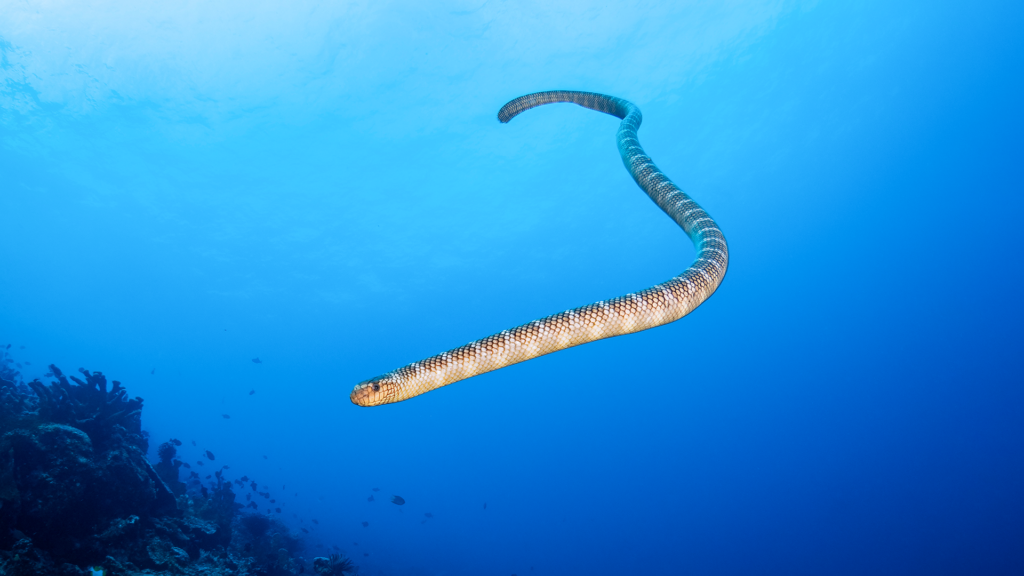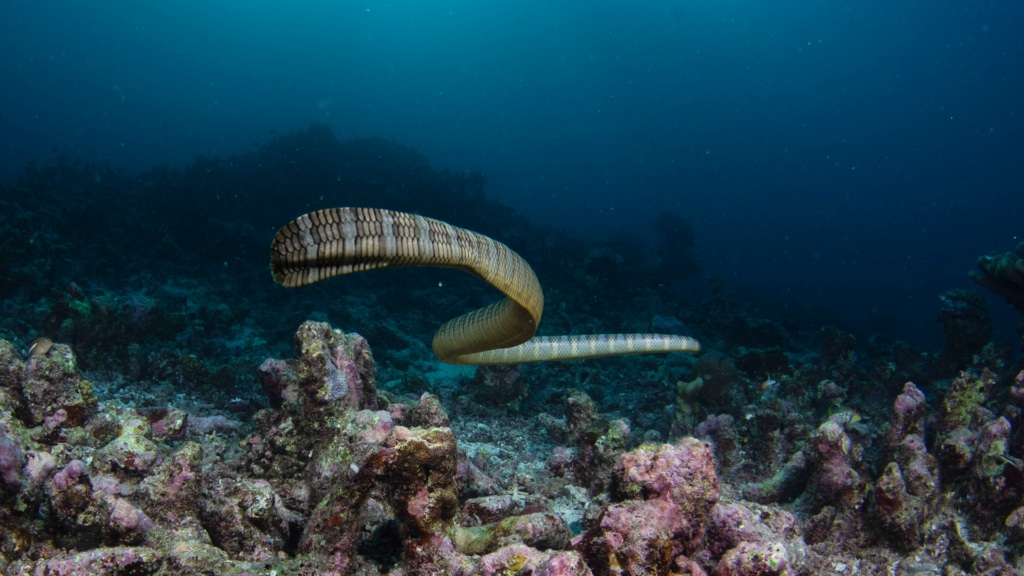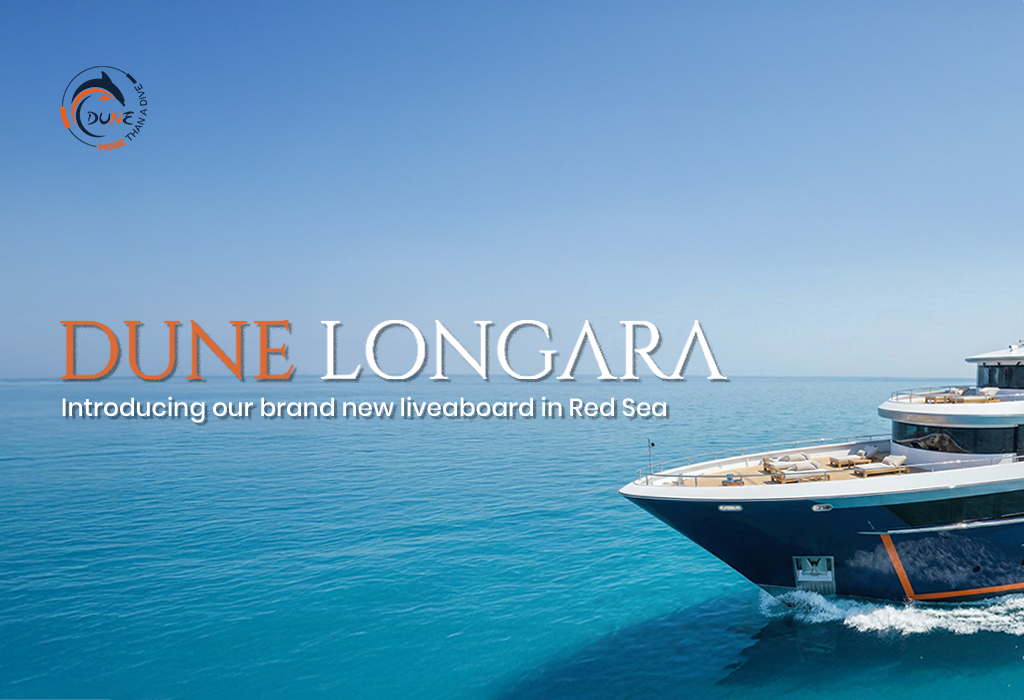
There are many secrets in the Banda Sea, which is frequently discussed among experienced divers as a frontier of the underwater world. However, few places are as fascinating or as exciting as Manuk Island. A remote volcanic outpost where hundreds of sea snakes rule supreme, is affectionately known as “Snake Island”. It is a testament to the raw, untamed power of nature and provides an unmatched opportunity to immerse oneself in a vibrant, geothermally active ecosystem.
Diving in Manuk Island, Banda Sea is a life-changing experience rather than just another item on a bucket list. Imagine descending into pristine waters with the occasional hint of sulfur in the air while elegant, frequently inquisitive sea snakes slither through the colorful reef surrounding you.
The Hypnotic Dance of the Serpents
The undisputed stars of Manuk Island are its abundant sea snakes, primarily the Banded Sea Krait (Laticauda colubrina) and the Olive Sea Snake (Aipysurus laevis). These highly venomous, yet remarkably docile, creatures are found in astonishing numbers, making their presence known from the moment you enter the water.
Perfectly adapted to their aquatic world, sea snakes glide through the water with effortless grace, propelled by their flattened, paddle-like tails. While they can remain submerged for extended periods, the magic often happens when they ascend to the surface for a breath of air. You’ll witness them break the surface with a quick gulp before descending once more, often completely unfazed by human presence. Their curious nature means they might swim incredibly close, occasionally even brushing against a fin or camera lens, seemingly uninterested in anything but their own journey.
A Word on Safety: It’s important to keep in mind that sea snakes are poisonous, even though they may appear calm. But bites are extremely uncommon and almost always happen when the snakes feel threatened, especially when they are handled or provoked. Respectful observation is essential to a secure and rewarding interaction. Never try to touch, grab, or corner these amazing reptiles; instead, keep a safe distance and refrain from making abrupt movements. It is a genuinely unique and secure experience to see them in their natural environment, unaltered and unprovoked.
Manuk Island: Where Earth’s Pulse Meets the Ocean
Manuk Island isn’t just an island; it’s an active volcano, a vibrant participant in Indonesia’s fiery “Ring of Fire.” This geological dynamism profoundly shapes the underwater landscape, creating dramatic walls, plunging slopes, and intricate rock formations sculpted by ancient lava flows.
The island’s dynamic nature is an integral part of the dive, not merely a historical anecdote. As your liveaboard gets closer, you may detect a faint, earthy sulfurous smell. The indications of geothermal activity are even more noticeable underwater. As temperatures change, warm water and gas are released from the seafloor by gentle hydrothermal vents, producing glistening visual effects. In some places, the water itself may feel noticeably warmer, and patches of sand may tremble or bubble visibly. By providing them with warmer waters and influencing the prey they hunt, these mineral-rich emissions are thought to be a major factor in drawing in the large populations of sea snakes. It serves as a sobering reminder that you are diving onto a planet that is actually alive.
Beyond the Serpents: A Rich Tapestry of Marine Life

Even though the sea snakes are the main draw, concentrating only on them would leave out the larger picture of Manuk’s thriving marine environment. A thriving community of other marine inhabitants and pristine coral health are guaranteed by its remote location in the Banda Sea.
Expect to see impressive schools of barracuda, jacks, and trevally, which often swirl in fascinating formations or cruise the deeper reef sections. Pelagic predators like snapper and tuna also patrol the blue on a regular basis. The sturdy hard corals and colorful soft corals that cover the volcanic structures themselves provide food and shelter for a variety of reef fish. Numerous damselfish, surgeonfish, angelfish, and parrotfish are visible, and they all contribute to the reef’s colorful structure. Though it’s not a given, there’s always a chance of seeing a passing reef shark or even a graceful mobula ray because Manuk Island’s ecosystem is so remote and healthy.
The Banda Sea Liveaboard Imperative: Reaching This Remote Gem
Due to its remote location hundreds of kilometers away from any significant landmass Manuk Island can only be reached by liveaboard. This remoteness is a huge benefit rather than a drawback because it maintains its unmatched pristine condition and guarantees an uncrowded, truly wild diving experience.
Manuk Island is usually included in liveaboard itineraries that are a part of larger Banda Sea Liveaboard expeditions. Sea conditions are at their best during the calmer inter-monsoon months, which are typically March to May and September to November. The luxury of several dives per day is provided by these multi-day excursions, giving you plenty of time to visit Manuk Island’s Banda Sea many dive sites and take in its distinct atmosphere. The actual trip transforms into an integral part of the journey, crossing huge expanses of open sea, frequently with a starry sky, to arrive at this unmatched location.
Diving in Manuk Island, Banda Sea is an intimate communion with one of nature’s most remarkable spectacles, and it’s more than just crossing something off a diver’s bucket list. A living volcano serves as the backdrop for this unique opportunity to see hundreds of sea snakes in their unaltered natural habitat. This adventure turns a dive trip into a once-in-a-lifetime experience exploring one of the most distinctive and alluring underwater environments on the planet.





